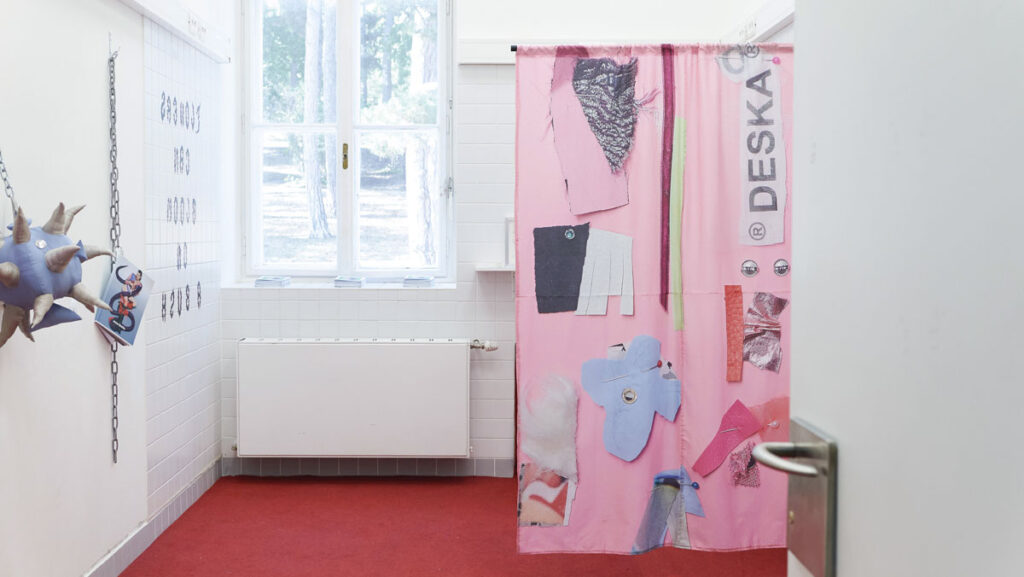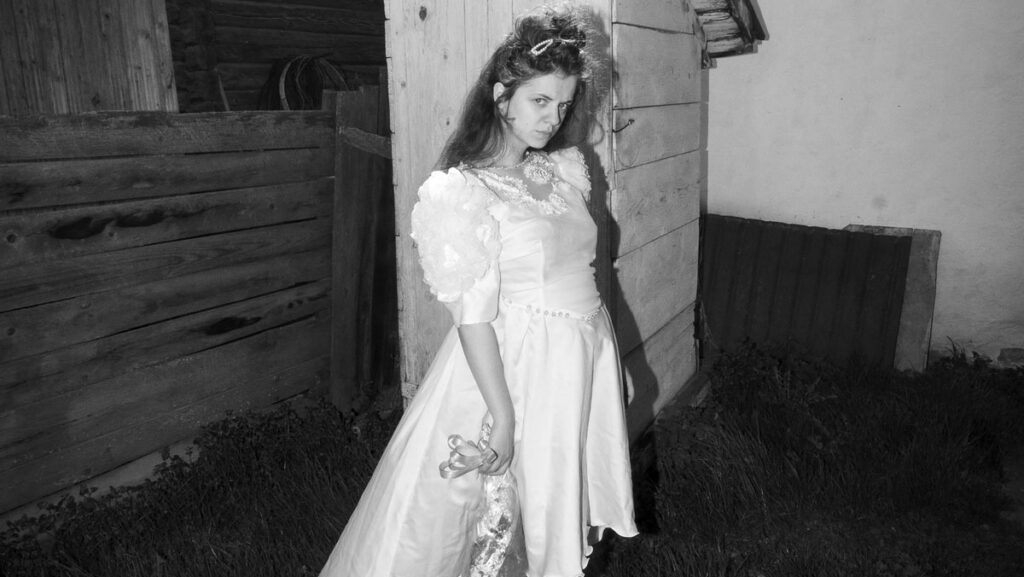
I’d like to start by asking about your background and how you arrived at the point where you’re doing what you do now.
I come from a background in music—classical music, to be specific—but I eventually transitioned to choreography. However, I quickly realized that choreography alone wasn’t enough for me. I was constantly searching for other elements that could enrich my practice. That’s when I began designing my own stage settings for performances. Over time, these stage settings became increasingly important to me, so much so that now, there’s often more emphasis on the stage itself than on the performance taking place on it. My work has become more installative, but it remains closely connected to music and movement—those elements are still essential to what I do. What makes the piece authentic is the movement that occurs within these staged spaces—the interaction between the performers‘ bodies and the stage elements. In the context of “Blinds”, the focus is on the performers‘ movements with the curtains. In my last five projects, my approach has been to have the performers engage more deeply with the materiality of the stage rather than being the central focus of the performance. This is the current direction of my work.

When did this shift or growing interest in choreography, and later in stage design and music in relation to performance, take place?
I began my artistic journey by studying the violin, my first real connection to the arts. Even back then, my teachers would often tell me that I moved too much while playing. I was always searching for a more holistic experience. For me, just playing music wasn’t enough; something always felt missing. That’s what led me to dance. I even tried to combine dancing with playing the violin, but I still felt a lingering question about the space around me as I performed. It made me think about how to incorporate that spatial awareness into my practice. I’ve always felt a need to bring all the elements together—to make sure that everything is interconnected and considered equally. I can’t ignore what’s present around me, so I’ve learned to use and combine all the available parameters in my work.

When it comes to “Blinds”, the black color of the curtains feels very powerful, further highlighting the theater space and the traditional darkness present in the room during a performance. Have you always worked in a monochromatic style in terms of the space?
I don’t see the black here as monochromatic. There are so many variations of black—there’s a velvet black, a shiny black, and a transparent black. The textures and qualities of the fabrics used for the curtains are diverse.
Do you see these shades of black and different fabric textures as forming a kind of landscape from one perspective?
Yes, it’s a unified composition. It’s not colorful or contrasting but rather creates a foundation—a cohesive base for the piece.
Yes, I felt the piece was animated. When I say animated, I mean it in a very analog sense, where the backdrop or base, the physicality of the performers, and the music all come together in movement. I found that very specific. The piece could be described as a performative installation. How do you understand and apply that phrase in your practice?
In this case, the installation is not just spatial; it’s also a sound installation. At the moment, the space might seem more prominent, but that’s influenced by the site-specific nature of Toihaus, where there’s a sign outside saying ‚THEATER.‘ When people enter, they often expect something narrative-based. So, in this context, the piece might seem more focused on the spatial installation. There’s no such thing as a neutral space, but in an ideally neutral venue, the piece might look different. The music, composed by an organist, is not random; it can be experienced autonomously. From a musical perspective, “Blinds” could even work in a concert hall—it all depends on the context where the piece takes place. I always strive to bring all elements of the piece—space, movement, sound—into balance, giving them equal value. Before the show, when the audience was gathering, we explained that it was a performative installation, where three performers would move through the installation, and the audience was invited to enter and walk through it as well. This breaks the wall of passiveness. The audience isn’t just there to watch, applaud, and leave—they’re invited to interact with the piece.


How long did the process of preparing “Blinds” take? Can you tell us more about the process behind it?
The production process began in the spring of this year when I worked with a technician to sew the curtains. Once the installation was complete, we spent two weeks conducting research with the performers and the installation, although the music hadn’t been finalized at that point. I invited three performers to join me for the research phase, with no fixed intention of presenting the piece to an audience just yet. The final cast wasn’t decided then, but these three performers connected with the piece so quickly and deeply that they convinced me they were the right cast for the final version. We then pushed to make it part of the Toihaus program and had a few more weeks of rehearsals. The rehearsals weren’t long—just a few hours each day—but we worked very intensely during those sessions. I also encouraged the performers to „digest“ the material outside of rehearsals. I trust them in the process of internalizing the movement and connecting it with their bodies and the materials.
It’s great to hear that there’s such a collaborative aspect to your work as an artistic director. How did the music creation process unfold, and how did you choose your collaborators?
This time, the process was a bit different from previous projects. I usually work with a few people regularly, like Elena Francalanci and Jan Leitner, who were part of the cast for my last works. For this project, I got in touch with Alexander Bauer, a composer and member of the NAMES ensemble, whose work I greatly admire. He joined one of the research days I held with the performers and said, ‚I can already hear some sounds.‘ From there, he started working on the music, and it was a nice, collaborative process. The music and performance elements were developed almost simultaneously. My taste in music leans toward dark electronic sounds—monumental and self-contained—and that influence certainly played a role in the creation of this piece.

You mentioned monumentality, and I would like to ask: how do you perceive the whole constellation in „Blinds“ as monumental?
When the piece is finished and we share our experiences after watching it, I hear many different thoughts and a wide variety of interpretations. While these interpretations arise from monumental thinking, this monumentality is called into question. Decisions are made about the „spectacle“ aspect of the piece. It may sound like I am discussing it in a certain way, but in reality, it is quite fragile. Yesterday, someone said to me in a talk, „You are sharing your thinking.“ That is true. I am trying to convey my thoughts about the curtain in „Blinds“, the water in „Leak“, clay, air, and so on. I show how I am thinking about these elements, including all their possibilities and impossibilities. What makes the piece authentic is the movement that occurs within and together with these staged spaces—the interaction between the performers ‚bodies and the materials. In the context of „Blinds,“ the focus is on the performers ‚movements in relation to the curtains. The performers themselves move the curtains. They are dependent on each other. In my last four projects, my approach has been to have the performers engage more deeply with the materiality of the stage so that an equal focus is on all levels. This is the current direction of my work.
What interests you in music or art outside of your projects? What do you listen to while researching?
It’s quite classical, but when I have free time, I spend a lot of time in nature. I often say that I prefer watching strawberries turn red than doing something else, and I sometimes claim that this is already art. In addition to my interest in electronic music, I have traveled to Japan frequently and lived there for a while. I have a deep interest in Japanese gardening, especially IKEBANA, the art of Japanese flower arrangement. Everything is already present in that practice—space, music, and time. I conduct a lot of research on these topics, which resonate back to my work and are, of course, very visible later.

What are the projects you are involved in that are planned at Toihaus in the near future?
From these curtains, we will develop a performance for a diverse audience on Sunday mornings. We are focused here at the house on making the pieces accessible to everyone, regardless of age or social status, and creating a program that brings art closer to people in an inclusive way.
Will “Blinds” be shown at other venues as well? Is anything planned already?
Yes, it will take place next year in Berlin, but this time not in a theater context. I am working on a concept that includes installation and a live musician on stage, allowing us to present it at music festivals. The piece is flexible in the sense that some parameters can change and adapt, making it a good experimental field for us.

Cornelia Böhnisch, since autumn 2018, the co-artistic director of the Toihaus Theater in Salzburg, seeks in her choreographies what she calls ‚precision in blurriness‘: unfamiliar images that faintly emerge from the darkness. In her work, space, music, movement, and materials converge, condensing into newly explored landscapes. Whether for children or adults, a concept in Cornelia Böhnisch’s work must contain something impossible: techno composed from water droplets, making a gigantic pile of clothes dance, or causing the moon to drip. This embodies the driving force behind her artistic exploration: a childlike sense of justice, a yearning for healing and salvation. Born and raised in Tübingen, the city of the poet Hölderlin, Cornelia Böhnisch learned to play the violin and piano as a child. She studied contemporary dance at the Bruckner Conservatory in Linz, and in 2010/11, she was awarded a foreign scholarship by the Austrian Federal Ministry for Art and Culture to study in Berlin and Tokyo. She has since made several trips to Japan, and its culture continues to significantly shape her reflections and questions. As the co-artistic director of Toihaus, Cornelia Böhnisch collaborates closely with Katharina Schrott. Their joint efforts were recognized in 2022 with the main prize of the Cultural Fund of the City of Salzburg, honoring their outstanding artistic collaboration and significant contribution to art and culture. www.connie.tokyo
You can find the ticket and the entire program with all the information here: www.toihaus.at
Address and contact:
Toihaus Theater Salzburg
Franz-Josef-Straße 4, 5020 Salzburg
www.toihaus.at
“Blinds” Performative Installation. In “Blinds”, Cornelia Böhnisch connects the top and the bottom: Curtain panels are moved up and down by three performers and begin to breathe mechanically. The shadows cast by the folds suggest a life behind the things, the hidden and the suspected. The performative installation “Blinds” focuses on the intermediate state of a moving space in which the fragile moments of vulnerability are revealed.
Concept, space, and choreography: Cornelia Böhnisch
Performance: Kim Ceysens, Elena Francalanci, Julia Müllner
Music: Alexander Bauer
Dramaturgy: Felicitas Biller
Conceptual advice: Katharina Schrott
Curtain tailoring: Florian Kirchmayr
Lighting and technology: Florian Kirchmayr, Robert Schmidjell





